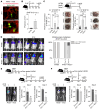Inducible CCR2+ nonclassical monocytes mediate the regression of cancer metastasis
- PMID: 39545417
- PMCID: PMC11563681
- DOI: 10.1172/JCI179527
Inducible CCR2+ nonclassical monocytes mediate the regression of cancer metastasis
Abstract
A major limitation of immunotherapy is the development of resistance resulting from cancer-mediated inhibition of host lymphocytes. Cancer cells release CCL2 to recruit classical monocytes expressing its receptor CCR2 for the promotion of metastasis and resistance to immunosurveillance. In the circulation, some CCR2-expressing classical monocytes lose CCR2 and differentiate into intravascular nonclassical monocytes that have anticancer properties but are unable to access extravascular tumor sites. We found that in mice and humans, an ontogenetically distinct subset of naturally underrepresented CCR2-expressing nonclassical monocytes was expanded during inflammatory states such as organ transplant and COVID-19 infection. These cells could be induced during health by treatment of classical monocytes with small-molecule activators of NOD2. The presence of CCR2 enabled these inducible nonclassical monocytes to infiltrate both intra- and extravascular metastatic sites of melanoma, lung, breast, and colon cancer in murine models, and they reversed the increased susceptibility of Nod2-/- mutant mice to cancer metastasis. Within the tumor colonies, CCR2+ nonclassical monocytes secreted CCL6 to recruit NK cells that mediated tumor regression, independent of T and B lymphocytes. Hence, pharmacological induction of CCR2+ nonclassical monocytes might be useful for immunotherapy-resistant cancers.
Keywords: Cancer; Immunology; Lung cancer.
Conflict of interest statement
Figures







References
-
- Nywening TM, et al. Targeting tumour-associated macrophages with CCR2 inhibition in combination with FOLFIRINOX in patients with borderline resectable and locally advanced pancreatic cancer: a single-centre, open-label, dose-finding, non-randomised, phase 1b trial. Lancet Oncol. 2016;17(5):651–662. doi: 10.1016/S1470-2045(16)00078-4. - DOI - PMC - PubMed
MeSH terms
Substances
Grants and funding
LinkOut - more resources
Full Text Sources
Molecular Biology Databases

